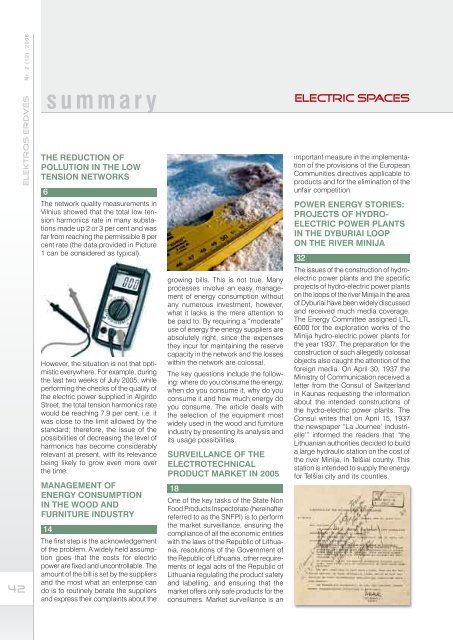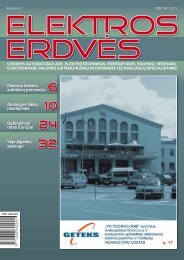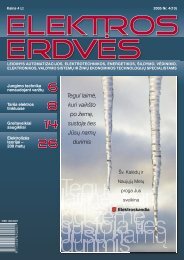Pramoninės ir komercinės paskirties technologinė - NETA
Pramoninės ir komercinės paskirties technologinė - NETA
Pramoninės ir komercinės paskirties technologinė - NETA
You also want an ePaper? Increase the reach of your titles
YUMPU automatically turns print PDFs into web optimized ePapers that Google loves.
Elektros Erdvës N r. 2 (12) 2006<br />
42<br />
s u m m a r y<br />
THE REDUCTION OF<br />
POLLUTION IN THE LOW<br />
TENSION NETWORKS<br />
6<br />
The network quality measurements in<br />
Vilnius showed that the total low tension<br />
harmonics rate in many substations<br />
made up 2 or 3 per cent and was<br />
far from reaching the permissible 8 per<br />
cent rate (the data provided in Picture<br />
1 can be considered as typical).<br />
However, the situation is not that optimistic<br />
everywhere. For example, during<br />
the last two weeks of July 2005, while<br />
performing the checks of the quality of<br />
the electric power supplied in Alg<strong>ir</strong>do<br />
Street, the total tension harmonics rate<br />
would be reaching 7.9 per cent, i.e. it<br />
was close to the limit allowed by the<br />
standard; therefore, the issue of the<br />
possibilities of decreasing the level of<br />
harmonics has become considerably<br />
relevant at present, with its relevance<br />
being likely to grow even more over<br />
the time.<br />
MANAGEMENT OF<br />
ENERGY CONSUMPTION<br />
IN THE WOOD AND<br />
FURNITURE INDUSTRY<br />
14<br />
The f<strong>ir</strong>st step is the acknowledgement<br />
of the problem. A widely held assumption<br />
goes that the costs for electric<br />
power are fixed and uncontrollable. The<br />
amount of the bill is set by the suppliers<br />
and the most what an enterprise can<br />
do is to routinely berate the suppliers<br />
and express the<strong>ir</strong> complaints about the<br />
growing bills. This is not true. Many<br />
processes involve an easy management<br />
of energy consumption without<br />
any numerous investment, however,<br />
what it lacks is the mere attention to<br />
be paid to. By requ<strong>ir</strong>ing a “moderate”<br />
use of energy the energy suppliers are<br />
absolutely right, since the expenses<br />
they incur for maintaining the reserve<br />
capacity in the network and the losses<br />
within the network are colossal.<br />
The key questions include the following:<br />
where do you consume the energy,<br />
when do you consume it, why do you<br />
consume it and how much energy do<br />
you consume. The article deals with<br />
the selection of the equipment most<br />
widely used in the wood and furniture<br />
industry by presenting its analysis and<br />
its usage possibilities.<br />
SURVEILLANCE OF THE<br />
ELECTROTECHNICAL<br />
PRODUCT MARKET IN 2005<br />
18<br />
One of the key tasks of the State Non<br />
Food Products Inspectorate (hereinafter<br />
referred to as the SNFPI) is to perform<br />
the market surveillance, ensuring the<br />
compliance of all the economic entities<br />
with the laws of the Republic of Lithuania,<br />
resolutions of the Government of<br />
the Republic of Lithuania, other requ<strong>ir</strong>ements<br />
of legal acts of the Republic of<br />
Lithuania regulating the product safety<br />
and labelling, and ensuring that the<br />
market offers only safe products for the<br />
consumers. Market surveillance is an<br />
electric spaces<br />
important measure in the implementation<br />
of the provisions of the European<br />
Communities d<strong>ir</strong>ectives applicable to<br />
products and for the elimination of the<br />
unfa<strong>ir</strong> competition.<br />
POWER ENERGY STORIES:<br />
PROJECTS OF HYDRO-<br />
ELECTRIC POWER PLANTS<br />
IN THE DYBURIAI LOOP<br />
ON THE RIVER MINIJA<br />
32<br />
The issues of the construction of hydroelectric<br />
power plants and the specific<br />
projects of hydro-electric power plants<br />
on the loops of the river Minija in the area<br />
of Dyburiai have been widely discussed<br />
and received much media coverage.<br />
The Energy Committee assigned LTL<br />
6000 for the exploration works of the<br />
Minija hydro-electric power plants for<br />
the year 1937. The preparation for the<br />
construction of such allegedly colossal<br />
objects also caught the attention of the<br />
foreign media. On April 30, 1937 the<br />
Ministry of Communication received a<br />
letter from the Consul of Switzerland<br />
in Kaunas requesting the information<br />
about the intended constructions of<br />
the hydro-electric power plants. The<br />
Consul writes that on April 15, 1937<br />
the newspaper “La Journee‘ industrielle‘”<br />
informed the readers that “the<br />
Lithuanian authorities decided to build<br />
a large hydraulic station on the cost of<br />
the river Minija, in Telðiai county. This<br />
station is intended to supply the energy<br />
for Telðiai city and its counties.






